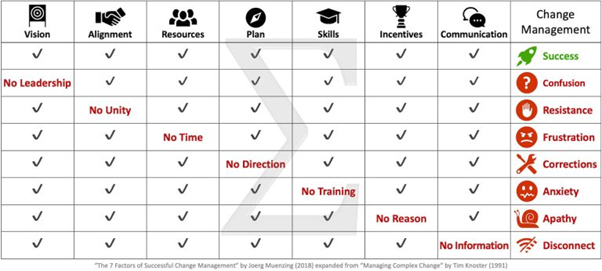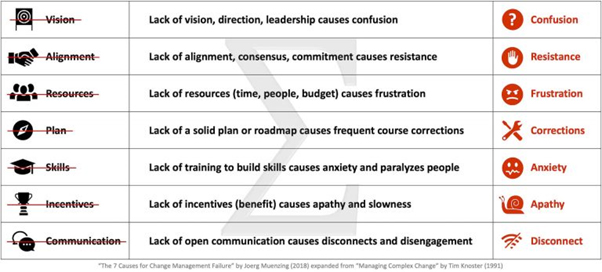
The 5 Key Roles
Selecting the right type of assistance depends largely on current conditions, capabilities, timeline, and desired impact. There are five levels to engage external support, from “light touch” to “strong lead”, in the role of a (1) Coach, (2) Advisor, (3) Stimulator, (4) Navigator, (5) Commander:
Coach
➤ Involvement: 5% for monthly coaching session, totaling 1 workday per month.
➤ Method: The expert actively listens and shows understanding for the problem, asks guiding questions and provides a view.
➤ Benefit: It gives people all the time and space they need to decide whatever is right for them.
➤ Risk: Freedom of choice can induce stress to find the right path. People may find it more gratifying to select from a smaller menu of selected options with a clear path plotted on how to become more successful.
➤ Application: When a leader wants a sparring partner to listen and provide feedback, validate options before deciding.
Advisor
➤ Involvement: 10% for bi-weekly performance review and feedback, totaling 2 workdays per month.
➤ Method: The expert performs the analysis, helps the team identifying root causes, and provides advice to managers making the decision.
➤ Benefit: In this education intervention, the role of expert is to help people understand what is happening, what is coming, and how this change might impact them. It allows people to accept or reject the given advice.
➤ Risk: Engaging into endless discussions without any real action.
➤ Application: When people need specialist knowledge to understand and commit, such as for a pre-merger analysis or business process redesign.
Stimulator
➤ Involvement: 25% for weekly performance analysis and coaching, totaling 5 workdays per month.
➤ Method: The expert helps people to understand and encourages them to try new things, while getting key people involved so others will follow.
➤ Benefit: The stimulator creates change through presence. It leaves a large degree of control with the individual but there is an indirect push by management toward a specific outcome.
➤ Risk: People might get irritated from the indirect approach and semi-soft actions, provoking a backlash.
➤ Application: When internal action is not sufficient or not appropriate; driving results through persistent follow-up.
Navigator
➤ Involvement: 50% for part-time management support onsite, totaling 10 workdays per month.
➤ Method: Authority and most decisions are delegated to the consultant who retains significant authority over the direction of the project.
➤ Benefit: Taking the helm includes others in the change process, helping quick learners develop the skills towards independence.
➤ Risk: Uncertainties from a shared directive make it less clear on who is in charge; managers can become resentful because of limited control. Requires roles and responsibilities to be clarified so people find their places in the transition.
➤ Application: When changing the way of working (WOW), implementing a major project, program, or system.
Commander
➤ Involvement: 100% for full-time interim management, totaling 20 workdays per month.
➤ Method: The consultant or interim manager owns the process and has full control over resources, while the client is fully dependent on the external leader.
➤ Benefit: Speed, simplicity, and autonomy for the leader to get things done.
➤ Risk: Can scare people and make them feel powerless. Successful when the consultant takes full control, while coaching individuals, helping them grow towards independence.
➤ Application: When internal capability or bandwidth are insufficient to achieve desired results, such as in turnaround situations.
The three common modes to engage external support is as a team member, co-leader, or interim manager.

Internal Control | Team Member
➤ Role: The external expert complements the internal team, provides the critical knowledge to analyze the problem and develop the solution.
➤ Principle: When the client steers the program, the new knowledge will modify behaviors and deliver better results.
➤ Process: By offering information about trend, impact, and consequences of not acting, people might try new ways or not.
➤ Application: Bottom-up improvement initiatives, where the desired change does not depend on a directive, new capabilities, or an external process.
➤ Example: Analysis of gaps and trends that lead to improvement ideas and projects.
Shared Control | Co-Leadership
➤ Role: The external expert provides subject-matter expertise, assisting the internal leader to execute the program, while coaching the team.
➤ Principle: When sharing control between client and consultant, the jointly developed solution will lead to better results.
➤ Process: When co-leading the transition, success depends on a clear direction, level of buy-in, and strong alignment between both parties.
➤ Application: Central improvement program, led by senior management, and strongly supported by the external expert.
➤ Example: Developing a new organizational structure or evolving the business model.


External Control | Interim Manager
➤ Role: The external expert leads the internal team ad interim, until targets are achieved, and systems are in place to sustain them.
➤ Process: By providing a directive, people may comply under pressure, while their fundamental believes remain unchanged.
➤ Application: Crisis, when the deadline is near, or when rapid change or strict consequence management is required.
➤ Example: Turnaround to bring performance on target or a mission-critical project on track.
Hiring External Support :
➤ Engaging a consultant or interim manager to effectively act as coach, advisor, stimulator, navigator, or commander requires defining role, responsibility, authority, accountability. Especially important is deciding who controls the process and is accountable for the result.
The three common modes to engage external support is as a team member, co-leader, or interim manager.
Why Engaging with Us?
➤ Flexible staffing, from part time to full time
➤ Cost-efficient delivery of programs, projects
➤ Scale up when more support is required.
➤ Ramp down as improvements take hold.
➤ Result-focus to make the needle move.
➤ 95% repeat clients
Why Roles Evolve Over Time
Because the delivery of sustainable value through change involves introducing and embedding multiple policies and practices across multiple functions and entities, the role of the consultant and the type of control changes over time. Here are two examples:
An engagement started with a benchmarking exercise to identify opportunities and create an improvement proposal (Advisor). The client then decided to hire additional support to lead the implementation (Commander), while providing training sessions (Coach).
An operational crisis-situation required an experienced interim manager (Commander) to lead the turnaround, followed by rounds of education interventions for stakeholders to build required skills and capabilities (Coach), and a series of nudges to initiate action (Stimulator).
Conclusion: To realize sustainable value, it is important to develop a cohesive and coherent change strategy, supported by a robust implementation roadmap, rather than initiating quick-fix actions that don’t get you anywhere.
Ensuring Mission Success – The 7 Key Factors
To deliver lasting change, a program must be intelligently designed, resourced, and executed. We help you putting all seven key success factors in place:
(1) a compelling Vision to clarify the future state.
(2) solid Alignment between stakeholders to ensure everyone is on board and on the same page.
(3) sufficient Resources allocated to execute the improvement.
(4) a detailed Plan so everyone is clear on what to do.
(5) sufficient Skills and capabilities to move forward and meet requirements; (6) Incentives that motivates people to act; and
(7) an open Communication to get people involved and behind the mission

Preventing Mission Failure – The 7 Reasons
Programs and projects fail for one or several of these seven reasons:
(1) lack of Vision or the absence of leadership causes confusion because the future state is unclear,
(2) lack of Alignment causes resistance when stakeholders do not see the same problem or solution,
(3) lack of Resources causes frustration when there is not enough time, not enough people, or not enough budget allocated.
(4) lack of a robust Plan causes false starts and frequent course corrections to get back on track.
(5) lack of Skills and capabilities causes inaction, mistakes, and fear of failure.
(6) lack of Incentives causes apathy and slowness because there is no reason to act; and
(7) lack of Communication keeps people uninformed, causes disconnects and disengagement. Following these simple steps significantly reduces the risk of project failure:
➤ Client defines the vision or objective and allocates required resources to implement it.
➤ Both parties jointly develop the roadmap and ensure all key stakeholders are on board.
➤ Chools Consulting provides the know-how to co-develop solutions together with the client team.
➤ Client communicates the program and its goals and provides incentives for people to act.
➤ Both parties relentlessly follow through on commitments, remove barriers to ensure success

Navigating to Results
We accelerate your improvement journey by providing the critical know-how and the hands-on implementation assistance, so you achieve results faster.
